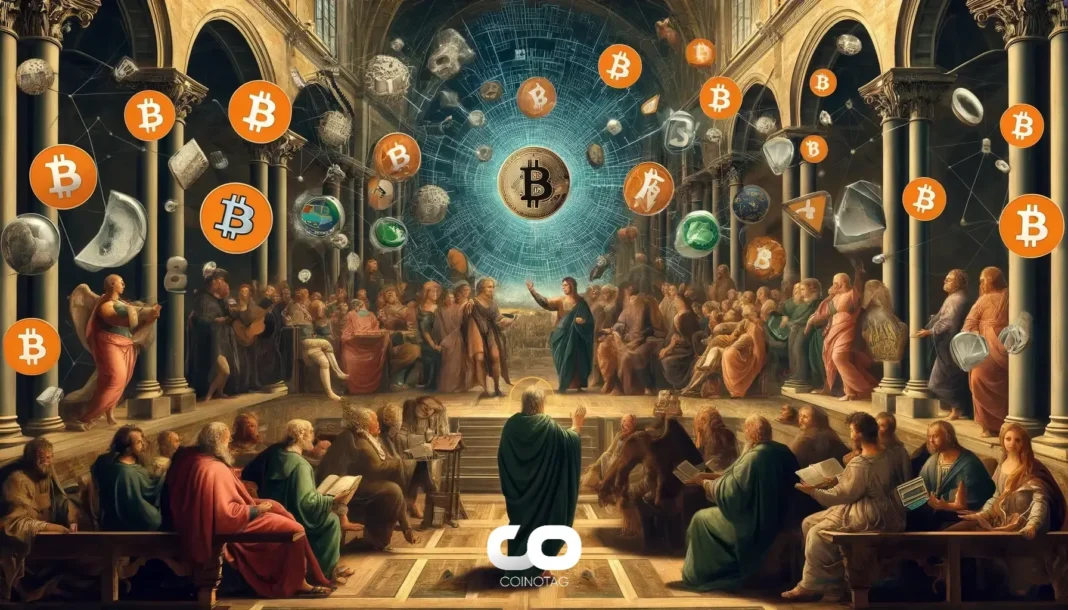| COINOTAG recommends • Exchange signup |
| 💹 Trade with pro tools |
| Fast execution, robust charts, clean risk controls. |
| 👉 Open account → |
| COINOTAG recommends • Exchange signup |
| 🚀 Smooth orders, clear control |
| Advanced order types and market depth in one view. |
| 👉 Create account → |
| COINOTAG recommends • Exchange signup |
| 📈 Clarity in volatile markets |
| Plan entries & exits, manage positions with discipline. |
| 👉 Sign up → |
| COINOTAG recommends • Exchange signup |
| ⚡ Speed, depth, reliability |
| Execute confidently when timing matters. |
| 👉 Open account → |
| COINOTAG recommends • Exchange signup |
| 🧭 A focused workflow for traders |
| Alerts, watchlists, and a repeatable process. |
| 👉 Get started → |
| COINOTAG recommends • Exchange signup |
| ✅ Data‑driven decisions |
| Focus on process—not noise. |
| 👉 Sign up → |
-
Ripple’s CTO David Schwartz signals a transformative vision for XRP and the XRPL ecosystem, positioning it as a comprehensive financial system beyond just cryptocurrency.
-
Schwartz emphasizes the XRPL’s potential to integrate tokenized real-world assets, stablecoins like RLUSD, and lending markets, aiming to rival traditional finance with enhanced speed and openness.
-
According to COINOTAG, Schwartz highlights XRP’s unique role as the sole asset without a counterparty, essential for liquidity and transaction fees within the XRPL network.
Ripple CTO outlines XRPL’s evolution into a decentralized financial system, leveraging XRP and stablecoins to expand beyond payments into loans and investments.
Ripple CTO Envisions XRPL as a Full-Fledged Financial Ecosystem
David Schwartz, Ripple’s Chief Technology Officer, has articulated a clear and ambitious roadmap for the XRP Ledger (XRPL), framing it as more than a mere payment protocol. He envisions the XRPL evolving into a decentralized financial system capable of supporting a broad spectrum of financial services traditionally dominated by banks and fintechs. This includes tokenized real-world assets, stablecoins such as RLUSD, and lending markets, all integrated within a fast, open, and efficient blockchain infrastructure.
XRPL’s Structural Advantages and XRP’s Unique Role
At the heart of this vision lies XRP, which Schwartz describes as the only asset on the XRPL without a counterparty, making it uniquely suited for universal acceptance and transaction fee payments. The network’s design prioritizes XRP for liquidity management through mechanisms like autobridging and pathfinding, which facilitate seamless asset exchanges. This structural advantage ensures XRP remains central even as the ecosystem diversifies with new tokens and financial instruments.
Expanding XRPL Utility Beyond Payments
Schwartz stresses that the XRPL is not limited to facilitating payments but is poised to encompass a wider range of financial activities. By integrating stablecoins and enabling tokenization of assets, the XRPL aims to support lending, investments, and other financial products. This expansion aligns with Ripple’s goal to create a blockchain-based financial stack that operates with the speed and transparency demanded by modern markets, potentially disrupting traditional financial intermediaries.
| COINOTAG recommends • Professional traders group |
| 💎 Join a professional trading community |
| Work with senior traders, research‑backed setups, and risk‑first frameworks. |
| 👉 Join the group → |
| COINOTAG recommends • Professional traders group |
| 📊 Transparent performance, real process |
| Spot strategies with documented months of triple‑digit runs during strong trends; futures plans use defined R:R and sizing. |
| 👉 Get access → |
| COINOTAG recommends • Professional traders group |
| 🧭 Research → Plan → Execute |
| Daily levels, watchlists, and post‑trade reviews to build consistency. |
| 👉 Join now → |
| COINOTAG recommends • Professional traders group |
| 🛡️ Risk comes first |
| Sizing methods, invalidation rules, and R‑multiples baked into every plan. |
| 👉 Start today → |
| COINOTAG recommends • Professional traders group |
| 🧠 Learn the “why” behind each trade |
| Live breakdowns, playbooks, and framework‑first education. |
| 👉 Join the group → |
| COINOTAG recommends • Professional traders group |
| 🚀 Insider • APEX • INNER CIRCLE |
| Choose the depth you need—tools, coaching, and member rooms. |
| 👉 Explore tiers → |
Challenges in Measuring XRPL’s Financial Impact
Despite the promising outlook, Schwartz acknowledges the difficulty in quantifying how much of XRP’s market value is directly attributable to XRPL activity. The evolving nature of the ecosystem and the introduction of diverse tokens complicate this assessment. Nonetheless, the strategic direction is clear: Ripple is building a comprehensive, decentralized financial infrastructure with XRP as a foundational asset but not the sole focus.
Conclusion
Ripple’s CTO David Schwartz presents a compelling vision for the XRPL as a multifaceted financial platform that transcends traditional cryptocurrency use cases. By leveraging XRP’s unique properties and expanding the ledger’s capabilities to include tokenized assets and stablecoins, Ripple is positioning itself at the forefront of blockchain-enabled finance. This approach promises to enhance efficiency, openness, and accessibility in financial services, signaling a significant shift in how blockchain technology can integrate with and potentially transform the global financial system.
| COINOTAG recommends • Exchange signup |
| 📈 Clear interface, precise orders |
| Sharp entries & exits with actionable alerts. |
| 👉 Create free account → |
| COINOTAG recommends • Exchange signup |
| 🧠 Smarter tools. Better decisions. |
| Depth analytics and risk features in one view. |
| 👉 Sign up → |
| COINOTAG recommends • Exchange signup |
| 🎯 Take control of entries & exits |
| Set alerts, define stops, execute consistently. |
| 👉 Open account → |
| COINOTAG recommends • Exchange signup |
| 🛠️ From idea to execution |
| Turn setups into plans with practical order types. |
| 👉 Join now → |
| COINOTAG recommends • Exchange signup |
| 📋 Trade your plan |
| Watchlists and routing that support focus. |
| 👉 Get started → |
| COINOTAG recommends • Exchange signup |
| 📊 Precision without the noise |
| Data‑first workflows for active traders. |
| 👉 Sign up → |
| COINOTAG recommends • Members‑only research |
| 📌 Curated setups, clearly explained |
| Entry, invalidation, targets, and R:R defined before execution. |
| 👉 Get access → |
| COINOTAG recommends • Members‑only research |
| 🧠 Data‑led decision making |
| Technical + flow + context synthesized into actionable plans. |
| 👉 Join now → |
| COINOTAG recommends • Members‑only research |
| 🧱 Consistency over hype |
| Repeatable rules, realistic expectations, and a calmer mindset. |
| 👉 Get access → |
| COINOTAG recommends • Members‑only research |
| 🕒 Patience is an edge |
| Wait for confirmation and manage risk with checklists. |
| 👉 Join now → |
| COINOTAG recommends • Members‑only research |
| 💼 Professional mentorship |
| Guidance from seasoned traders and structured feedback loops. |
| 👉 Get access → |
| COINOTAG recommends • Members‑only research |
| 🧮 Track • Review • Improve |
| Documented PnL tracking and post‑mortems to accelerate learning. |
| 👉 Join now → |






